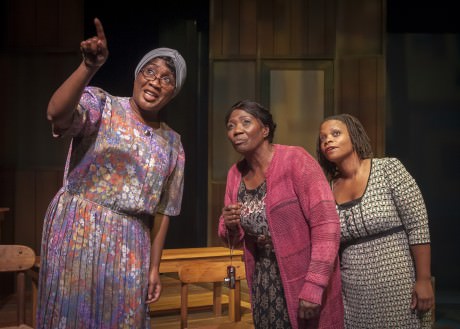“This ensemble was exquisite” — praise testimony of a theatergoer after seeing Gee’s Bend at MetroStage.
Amazing how a cast of just four performers are able to transform the simple life of the women of Gee’s Bend, Alabama into a triumphant recreation of the traditional culture of the rural South and the artistic expression of the art of quilting.

The quilt represents so much more than something to cover a bed. It’s an object that stitches things together. It layers and pads; it fills and fastens. It’s something that warms us and expresses life in material form.
Gee’s Bend weaves the essence of the quilt into a theatrical experience that exalts universal themes of family, faith, and overcoming adversity in a deeply moving way. The play is a visible metaphor for the message of making a way out of no way, of doing more with less, and like the quilt, for creating “something to be shared” as it connects, fills, pads and warms the audience in an expressive dramatic tapestry of movement, word, and song.
The log-cabin minimalism of Set Designer Betsy Muller’s natural wood panels, elemental flooring, unadorned furnishings set the scenery for the basic shapes and primary colors of the life of the women of Gee’s Bend.
Under the sensitive direction of Thomas W. Jones II, Gee’s Bend is the true story of a small African American community that sits in the large bend of the Alabama River. It takes you into the heart of the Black Belt of Alabama where African American women used to sing while they made quilts to make ends meet. These wonderful works of art were to eventually become part of the landscape of American folk art and hang in exhibition in prestigious galleries such as the Museum of Fine Arts, Houston, the Whitney Museum in New York City, The Corcoran in the nation’s capital, and the Philadelphia Museum of Art.
In the play’s time span from 1939 to the 2005, the ensemble of Roz White (Sadie), Margo Moorer, (Nella), Duyen Washington (Alice, Asia), and Anthony Manough (Macon) magnificently knit together a human quilt of perfect timing, balance, and acting precision.

Roz White (Sadie), the heroine of the story, gives an outstanding performance of a woman of substance as she defies her husband to become part of the Civil Rights Movement, facing danger when she tries to register to vote for the first time. Her character convincingly grows from a young girl in love to an aging woman who still walks with strength and dignity as she tenaciously holds onto her land and sense of family.
Brilliantly reprising the role of Nella that she originated for the world premiere at the Alabama Shakespeare Festival in 2007, Margo Moorer literally had the audience in stitches in her tell-it-like-it-is, bold yet humble portrayal of the heroine’s sister.
Duyen Washington (Alice, Asia) makes her debut in Gee’s Bend at MetroStage and gives a heartfelt performance as Mama.
The hot-headed character of Macon is dynamically portrayed by Anthony Manough, a fine actor who brings high-energy exuberance to the role of Sadie’s husband.
Playwright Elyzabeth Gregory Wilder has affectionately been dubbed an “honorary black girl” by Margo Moorer for sensing the soul of the women of Gee’s Bend and channeling that energy into this incredible work. Although Wilder translates the language of Gee’s Bend into a true theatrical tribute, there could have been more dialogue and stage time given to the women actually creating the quilts while singing– the way it was really done in Gee’s Bend. The script and choreography (Tom Jones) could have more closely connected the quilting with the spectacular a cappella gospel singing. It left me wanting more about the quilts and the art of quilt-making.
Like the simplicity of the quilt itself, the musical direction of William Hubbard and William Knowles combine the roots of African rhythms with the gospel music of old negro spirituals into a sound experience (Robert Garner) through percussion. Greg Holloway creates the atmosphere to accompany the experience of the quilters through chimes, tambourine, gourd and the bongo beat.
The minimalism of the life of the women of Gee’s Bend is also captured in the natural fiber costumes by Janine Sunday — the loose-fitting Granny housedress, headscarves and aprons in simple floral prints and cotton gingham.
Soft glowing lighting by Jessica Winfield on a stark set helped create moments of intensity and intimacy between actors and audience.
At the end of the play, in the very last scene, Margo Moorer could be seen wiping a tear from the corner of her eye.This didn’t appear to be part of Margo’s performance. In so many ways, Gee’s Bend will move you, too.
Running Time: 90 minutes, without an intermission.
Gee’s Bend plays through November 3, 2013 at MetroStage – 1201 North Royal Street, in Alexandria, VA. For tickets, call the box office at (703) 548-9044, or purchase them online.
LINK
Margo Moorer on Playing Nella in ‘Gee’s Bend’ at MetroStage by Joel Markowitz.





